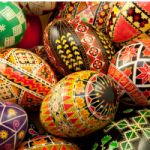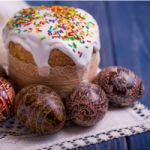 |
The Easter basket is at the heart of Ukrainian Easter
There are no strict rules regarding the Easter basket, as traditions vary from one region and one family to another with respect to what will be placed into the basket to be blessed. Nonetheless, there are several essentials:

Ukrainians have their own version of paska. Like brioche, it is a very rich, cakey bread made with eggs and butter. Paska was traditionally baked in a wood oven, though today it is most often made in a conventional oven. The traditional day to bake Paska was the Thursday before Easter. It was thought that if the starter-raised paska rose a lot, the following year would be a happy one; on the contrary, if it failed to rise, someone in the family might be leaving this world.

The pysanka (the word comes from the Ukrainian word pysaty, to write) has been part of popular tradition for centuries, even before Ukraine was officially Christianized in 988. In pre-Christian times, the egg symbolized the universe, with the yolk representing the sun and the white the moon. With the advent of Christianity, the egg became associated with Easter, a symbol of Christ's resurrection and the promise of eternal life.
Rural custom dictated that the peasant bury a pysanka in the first and last furrow of his field to ensure a good harvest. Some were placed in beehives to ensure honey, in stables for the health of the animals, in thatched roofs to protect from lightning, and inside the home itself for the protection of the family. Pysanki (the plural of pysanka) act as talismans or good luck symbols, but are also signs of Ukrainian cultural identity.
It's more than a tradition - it's an art. The most intricate eggs may take 3-4 hours work each. Ukrainian legend holds that as long as there is someone to decorate pysanky, the world will continue to exist.
The Easter basket also holds charcuterie, such as ham, sausage and bacon (symbols of sacrifice), dairy products like cottage cheese, butter (symbol of health) and hard cheese (symbol of maternity), salt (considered to bring luck), horseradish (which since it brings tears when grated is a reminder that life is not always easy), and beets, representing Mother Earth. In some regions, such as Transcarpathia, a bottle of wine is included, although some regions look down on such an addition.
Once the basket is filled, a candle is added which is lit during the mass when the baskets are blessed on Holy Saturday night. In the meantime, the basket is covered with a white cloth, intricately embroidered for this purpose.
The contents of the basket often represent in small quantities the foods that will be eaten at the Easter meal. Once the basket is blessed, nothing is to be discarded, not even the egg shells. They can, for example, be buried in the garden as a protection against evil spirits or to summon a bountiful harvest.
Paska is not the only food to adorn the Easter table. There is also:
First courses:
- Krashanky - Easter eggs
- Kovbasy - assorted sausages
- Paska - Easter bread
- Ukrainian beet salad
- Bourachky with chrin (grated beets with horseradish), and sweet bourachky (grated beets with sugar) to accompany the sausages and ham smoked over fruit wood.
Main dishes:
- Pork cutlets with dilled new potatoes
- Studenyna - headcheese
- Radish and new onion salad
Desserts:
- Syrna babka - Traditional Ukrainian cheesecake
Basket Photo: ID 93280110 / sonjachnyj / MSCOMM

-

 Recipes
Recipes
-

 Products
Products
-

 Entertaining
Entertaining
-

 Chefs
Chefs
-

 Hints & Tips
Hints & Tips
-

 Glossaries
Glossaries









